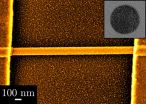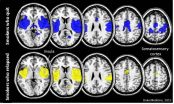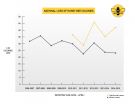Nano-policing pollution
2015-05-13
(Press-News.org) This news release is available in Japanese.
Pollutants emitted by factories and car exhausts affect humans who breathe in these harmful gases and also aggravate climate change up in the atmosphere. Being able to detect such emissions is a critically needed measure.
New research by the Nanoparticles by Design Unit at the Okinawa Institute of Science and Technology Graduate University (OIST), in collaboration with the Materials Center Leoben Austria and the Austrian Centre for Electron Microscopy and Nanoanalysis has developed an efficient way to improve methods for detecting polluting emissions using a sensor at the nanoscale. The paper was published in Nanotechnology.
The researchers used a copper oxide nanowire decorated with palladium nanoparticles to detect carbon monoxide, a common industrial pollutant. The sensor was tested in conditions similar to ambient air since future devices developed from this method will need to operate in these conditions.
Copper oxide is a semiconductor and scientists use nanowires fabricated from it to search for potential application in the microelectronics industry. But in gas sensing applications, copper oxide was much less widely investigated compared to other metal oxide materials.
A semiconductor can be made to experience dramatic changes in its electrical properties when a small amount of foreign atoms are made to attach to its surface at high temperatures. In this case, the copper oxide nanowire was made part of an electric circuit. The researchers detected carbon monoxide indirectly, by measuring the change in the resulting circuit's electrical resistance in presence of the gas. They found that copper oxide nanowires decorated with palladium nanoparticles show a significantly greater increase in electrical resistance in the presence of carbon monoxide than the same type of nanowires without the nanoparticles.
The OIST Nanoparticles by Design Unit used a sophisticated technique that allowed them to first sift nanoparticles according to size, then deliver and deposit the palladium nanoparticles onto the surface of the nanowires in an evenly distributed manner. This even dispersion of size selected nanoparticles and the resulting nanoparticles-nanowire interactions are crucial to get an enhanced electrical response. The OIST nanoparticle deposition system can be tailored to deposit multiple types of nanoparticles at the same time, segregated on distinct areas of the wafer where the nanowire sits. In other words, this system can be engineered to be able to detect multiple kinds of gases. The next step is to detect different gases at the same time by using multiple sensor devices, with each device utilizing a different type of nanoparticle.
Compared to other options being explored in gas sensing which are bulky and difficult to miniaturize, nanowire gas sensors will be cheaper and potentially easier to mass produce.
The main energy cost in operating this kind of a sensor will be the high temperatures necessary to facilitate the chemical reactions for ensuring certain electrical response. In this study 350 degree centigrade was used. However, different nanowire-nanoparticle material configurations are currently being investigated in order to lower the operating temperature of this system.
"I think nanoparticle-decorated nanowires have a huge potential for practical applications as it is possible to incorporate this type of technology into industrial devices," said Stephan Steinhauer, a Japan Society for the Promotion of Science (JSPS) postdoctoral research fellow working under the supervision of Prof. Mukhles Sowwan at the OIST Nanoparticles by Design Unit.
INFORMATION:
[Attachments] See images for this press release:


ELSE PRESS RELEASES FROM THIS DATE:
2015-05-13
(Boston)--In the largest study to date that examines Post Traumatic Stress Disorder (PTSD) as a risk factor for cancer, researchers from Boston University School of Medicine (BUSM), have shown no evidence of an association.
The study, which appears in the European Journal of Epidemiology, is consistent with other population-based studies that report stressful life events generally are not associated with cancer incidence. In addition to corroborating results of other studies, this large population sample allowed for important stratified analyses that showed no strong ...
2015-05-13
Our bodies' hormones work together to tell us when to eat and when to stop. But for many people who are obese, this system is off-balance. Now scientists have designed a hormone-like compound to suppress hunger and boost satiety, or a full feeling, at the same time. They report in ACS' Journal of Medicinal Chemistry that obese mice given the compound for 14 days had a tendency to eat less than the other groups.
In their study, Constance Chollet and colleagues targeted two main receptors in the body that help keep appetite in check. When hormones bind to ghrelin receptors, ...
2015-05-13
WASHINGTON, D.C., May 13, 2015--Policymakers and practitioners have grown increasingly interested in measures of personal qualities other than cognitive ability--including self-control, grit, growth mindset, gratitude, purpose, emotional intelligence, and other beneficial personal qualities--that lead to student success. However, they need to move cautiously before using existing measures to evaluate educators, programs, and policies, or diagnosing children as having "non-cognitive" deficits, according to a review by Angela L. Duckworth and David Scott Yeager published ...
2015-05-13
Coffee has gone from dietary foe to friend in recent years, partly due to the revelation that it's rich in antioxidants. Now even spent coffee-grounds are gaining attention for being chock-full of these compounds, which have potential health benefits. In ACS' Journal of Agricultural and Food Chemistry, researchers explain how to extract antioxidants from the grounds. They then determined just how concentrated the antioxidants are.
María-Paz de Peña and colleagues note that coffee -- one of the most popular drinks in the world -- is a rich source of a group ...
2015-05-13
Several class-action lawsuits filed recently against the makers of flushable wet-wipes have brought to light a serious -- and unsavory -- problem: The popular cleaning products might be clogging sewer systems. But whether the manufacturers should be held accountable is still up in the air, according to an article in Chemical & Engineering News (C&EN), the weekly newsmagazine of the American Chemical Society.
Jessica Morrison, assistant editor at C&EN, reports that New York City alone claims to have spent more than $18 million over six years clearing wipes from its wastewater ...
2015-05-13
Rats have more heart than you might think. When one is drowning, another will put out a helping paw to rescue its mate. This is especially true for rats that previously had a watery near-death experience, says Nobuya Sato and colleagues of the Kwansei Gakuin University in Japan. Their findings are published in Springer's journal Animal Cognition.
Recent research has shown that a rat will help members of its own species to escape from a tubelike cage. The helping rat will show such prosocial behavior even if it does not gain any advantage from it. To see whether these ...
2015-05-13
DURHAM, N.C. - Smokers who are able to quit might actually be hard-wired for success, according to a study from Duke Medicine.
The study, published in Neuropsychopharmacology, showed greater connectivity among certain brain regions in people who successfully quit smoking compared to those who tried and failed.
The researchers analyzed MRI scans of 85 people taken one month before they attempted to quit. All participants stopped smoking and the researchers tracked their progress for 10 weeks. Forty-one participants relapsed. Looking back at the brain scans of the 44 ...
2015-05-13
Beekeepers across the United States lost more than 40 percent of their honey bee colonies during the year spanning April 2014 to April 2015, according to the latest results of an annual nationwide survey. While winter loss rates improved slightly compared to last year, summer losses--and consequently, total annual losses--were more severe. Commercial beekeepers were hit particularly hard by the high rate of summer losses, which outstripped winter losses for the first time in five years, stoking concerns over the long-term trend of poor health in honey bee colonies.
The ...
2015-05-13
MANHASSET, NY -- The Feinstein Institute for Medical Research, the research arm of the North Shore-LIJ Health System, and SetPoint Medical Inc., a biomedical technology company, today released the results of research on the therapeutic potential of vagus nerve stimulation. In a paper published by Bioelectronic Medicine, Kevin J. Tracey, MD, and his colleagues at the Feinstein Institute, explore how low-level electrical stimulation interacts with the body's nerves to reduce inflammation, a fundamental goal of bioelectronic medicine.
Prior to this study, it was not understood ...
2015-05-13
Scientists at The University of Manchester have made an important discovery about how certain cells stick to each other to form tissue.
The team from the Faculty of Life Sciences studied how cells in the skin and heart are bound together through structures called desmosomes. They wanted to understand how these junctions between the cells in the tissue are so strong.
Desmosomes are specialised for strong adhesion. They bind the tissue cells together to resist the rigours of everyday life and their failure can result in diseases of the skin and heart, including sudden ...
LAST 30 PRESS RELEASES:
[Press-News.org] Nano-policing pollution





